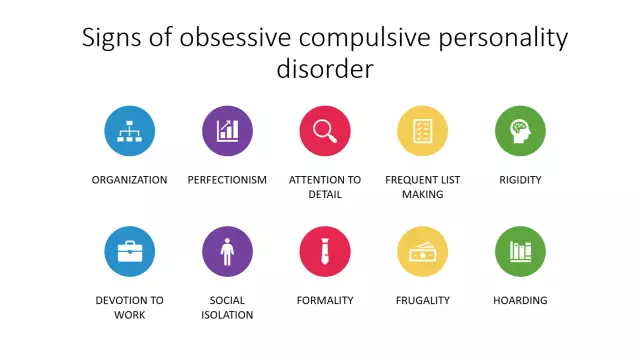- Author Rachel Wainwright [email protected].
- Public 2023-12-15 07:39.
- Last modified 2025-11-02 20:14.
Bipolar disorder
The content of the article:
- Causes and risk factors
- Forms of the disease
- Symptoms of bipolar disorder
- Diagnostics
- Treatment for bipolar disorder
- Potential consequences and complications
- Forecast
- Prevention
Bipolar disorder (bipolar disorder, manic-depressive psychosis) is a mental disorder that clinically presents with mood disorders (affective disorders). Patients experience an alternation of episodes of mania (or hypomania) and depression. From time to time, there is only mania or only depression. Intermediate, mixed states can also be observed.

Mood disorders occur in bipolar disorder
The disease was first described in 1854 by the French psychiatrists Falre and Bayerge. But as an independent nosological unit, it was recognized only in 1896, after Kraepelin's works devoted to a detailed study of this pathology were published.
Initially, the disease was called manic-depressive psychosis. But in 1993, it was included in the ICD-10 under the name bipolar disorder. This was due to the fact that psychoses do not always arise in this pathology.
There is no exact data on the prevalence of bipolar disorder. This is due to the fact that researchers of this pathology use different assessment criteria. In the 90s of the XX century, Russian psychiatrists believed that 0.45% of the population suffered from the disease. The assessment of foreign experts was different - 0.8% of the population. Currently, it is believed that 1% of people have symptoms of bipolar disorder, and in 30% of them, the disease becomes severely psychotic. There are no data on the incidence of bipolar disorder in children, which is due to certain difficulties in using standard diagnostic criteria in pediatric practice. Psychiatrists believe that in childhood, episodes of illness often go undiagnosed.
About half of patients develop bipolar disorder by the age of 25-45. In middle-aged people, unipolar forms of the disease predominate, and in young people, bipolar forms. Approximately 20% of patients have their first episode of bipolar disorder in their 50s. In this case, the frequency of depressive phases increases significantly.
Bipolar disorder is 1.5 times more common in women than in men. At the same time, bipolar forms of the disease are more often observed in men, and monopolar forms in women.
Causes and risk factors
The diagnosis of such a serious disease must be trusted by professionals, experienced specialists of the Alliance clinic (https://cmzmedical.ru/) will analyze your situation as accurately as possible and make the correct diagnosis.
The exact causes of bipolar disorder are not known. Hereditary (internal) and environmental (external) factors play a certain role. In this case, the greatest importance is assigned to hereditary predisposition.
Factors that increase your risk of developing bipolar disorder include:
- schizoid personality type (preference for solitary activity, a tendency to rationalize, emotional coldness and monotony);
- statotimic personality type (increased need for orderliness, responsibility, pedantry);
- melancholic personality type (increased fatigue, restraint in the manifestation of emotions, combined with high sensitivity);
- increased suspiciousness, anxiety;
- emotional instability.

The risk of developing bipolar disorder increases in women during hormonal fluctuations: pregnancy, childbirth, menopause, etc.
The risk of developing bipolar disorders in women increases significantly during periods of unstable hormonal levels (menstrual bleeding, pregnancy, postpartum or menopause). The risk is especially high for women with a history of psychoses in the postpartum period.
Forms of the disease
Clinicians use the classification of bipolar disorders based on the prevalence of depression or mania in the clinical picture, as well as on the nature of their alternation.
Bipolar disorder can be bipolar (there are two types of affective disorder) or unipolar (there is one affective disorder) form. The unipolar forms of pathology include periodic mania (hypomania) and periodic depression.
The bipolar form occurs in several variants:
- correctly intermittent - a clear alternation of mania and depression, which are separated by a light gap;
- incorrectly intermittent - the alternation of mania and depression occurs chaotically. For example, several episodes of depression, separated by a light interval, and then manic episodes can be observed in a row;
- double - two affective disorders immediately replace each other without a bright gap;
- circular - there is a constant change of mania and depression without light gaps.
The number of phases of mania and depression in bipolar disorder varies from patient to patient. Some have dozens of affective episodes during their lives, while others may have only one such episode.
The average duration of the bipolar disorder phase is several months. Moreover, episodes of mania occur less frequently than episodes of depression, and their duration is three times shorter.
In some patients with bipolar disorder, mixed episodes occur, which are characterized by a rapid change in mania and depression.
The average duration of the light gap in bipolar disorder is 3-7 years.
Symptoms of bipolar disorder
The main signs of bipolar disorder depend on the phase of the disease. So, the manic stage is characterized by:
- accelerated thinking;
- mood elevation;
- motor excitement.
There are three degrees of severity of mania:
- Light (hypomania). An elated mood, an increase in physical and mental performance, and social activity are noted. The patient becomes somewhat absent-minded, talkative, active and energetic. The need for rest and sleep decreases, while the need for sex, on the contrary, increases. In some patients, there is not euphoria, but dysphoria, which is characterized by the appearance of irritability, hostility to others. The duration of an episode of hypomania is several days.
- Moderate (mania without psychotic symptoms). There is a significant increase in physical and mental activity, a significant rise in mood. The need for sleep almost completely disappears. The patient is constantly distracted, cannot concentrate, as a result, his social contacts and interactions are hampered, and his ability to work is lost. Ideas of greatness arise. An episode of mild mania lasts at least a week.
- Severe (mania with psychotic symptoms). There is a pronounced psychomotor agitation, a tendency to violence. Leaps of thoughts appear, logical connection between facts is lost. Hallucinations and delusions develop, similar to the hallucinatory syndrome in schizophrenia. Patients gain confidence that their ancestors belonged to a noble and famous family (delusions of high origin) or consider themselves a famous person (delusions of greatness). Not only the ability to work is lost, but also the ability to self-service. Severe mania lasts over several weeks.

An unnaturally elevated mood is one of the symptoms of bipolar disorder
Depression in bipolar disorder has opposite symptoms to mania. These include:
- slow thinking;
- low mood;
- motor retardation;
- decrease in appetite, up to its complete absence;
- progressive weight loss;
- decreased libido;
- women stop menstruating and men can develop erectile dysfunction.
With mild depression on the background of bipolar disorder, patients' mood fluctuates during the day. It usually improves in the evening, and in the morning the manifestations of depression reach their maximum.
The following forms of depression can develop in bipolar disorder:
- simple - the clinical picture is represented by a depressive triad (depression of mood, inhibition of intellectual processes, impoverishment and weakening of the impulses for action);
- hypochondriacal - the patient is sure that he has a serious, deadly and incurable disease, or a disease unknown to modern medicine;
- delusional - the depressive triad is combined with the delusion of accusation. Patients agree with it and share it;
- agitated - with depression of this form, there is no motor retardation;
- anesthetic - the prevailing symptom in the clinical picture is a feeling of painful insensibility. The patient believes that all his feelings have disappeared, and an emptiness has formed in their place, which gives him severe suffering.

Different types of depression can occur with bipolar disorder
Diagnostics
For a diagnosis of bipolar disorder, the patient must have at least two episodes of affective disorders. Moreover, at least one of them must be either manic or mixed. For a correct diagnosis, the psychiatrist must take into account the characteristics of the patient's history, information received from his relatives.
Determination of the severity of depression is carried out using special scales.
The manic phase of bipolar disorder must be differentiated from agitation caused by the intake of psychoactive substances, lack of sleep or other reasons, and the depressive phase with psychogenic depression. Psychopathy, neuroses, schizophrenia, as well as affective disorders and other psychoses caused by somatic or nervous diseases should be excluded.
Treatment for bipolar disorder
The main goal of the treatment of bipolar disorder is to normalize the patient's mental state and mood, and achieve long-term remission. In severe cases of the disease, patients are hospitalized in the psychiatry department. Mild forms of the disorder can be treated on an outpatient basis.
Antidepressants are used to relieve a depressive episode. The choice of a specific drug, its dosage and frequency of administration in each case is determined by the psychiatrist, taking into account the patient's age, the severity of depression, the possibility of its transition to mania. If necessary, the appointment of antidepressants is supplemented with normotimics or antipsychotics.

Antidepressants help relieve depression in bipolar disorder
Drug treatment of bipolar disorder in the mania stage is carried out by normotimics, and in severe cases of the disease, antipsychotics are additionally prescribed.
In the stage of remission, psychotherapy (group, family and individual) is indicated.
Potential consequences and complications
If left untreated, bipolar disorder can progress. In a severe depressive phase, the patient is able to commit suicidal attempts, and during a manic phase, he is dangerous both for himself (accidents through negligence) and for the people around him.
Forecast
In the interictal period, mental functions are almost completely restored in patients with bipolar disorder. Despite this, the prognosis is poor. Recurrent attacks of bipolar disorder occur in 90% of patients, and over time, 30-50% of them permanently lose their ability to work and become disabled. In about one in three patients, bipolar disorder proceeds continuously, with minimal duration of light gaps or even their complete absence.
Often, bipolar disorder is combined with other mental disorders, drug addiction, alcoholism. In this case, the course of the disease and the prognosis are aggravated.
Prevention
Primary prevention measures for the development of bipolar disorder have not been developed, since the mechanism and reasons for the development of this pathology have not been precisely established.
Secondary prevention is aimed at maintaining a stable remission, preventing repeated episodes of affective disorders. For this, it is necessary that the patient does not arbitrarily stop the treatment prescribed for him. In addition, factors that contribute to the development of exacerbation of bipolar disorder should be excluded or minimized. These include:
- sharp changes in hormonal levels, endocrine system disorders;
- diseases of the brain;
- trauma;
- infectious and somatic diseases;
- stress, overwork, conflict situations in the family and / or at work;
- violations of the daily routine (insufficient sleep, busy work schedule).
Many experts associate the development of exacerbations of bipolar disorder with annual human biorhythms, since exacerbations often occur in spring and autumn. Therefore, at this time of year, patients should especially carefully adhere to a healthy, measured lifestyle and the recommendations of the attending physician.
YouTube video related to the article:

Elena Minkina Doctor anesthesiologist-resuscitator About the author
Education: graduated from the Tashkent State Medical Institute, specializing in general medicine in 1991. Repeatedly passed refresher courses.
Work experience: anesthesiologist-resuscitator of the city maternity complex, resuscitator of the hemodialysis department.
The information is generalized and provided for informational purposes only. At the first sign of illness, see your doctor. Self-medication is hazardous to health!






